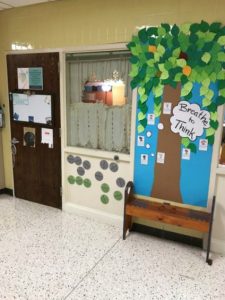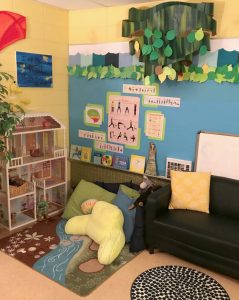Operating a therapy practice within a school building has provided me an opportunity to reflect on and address the importance of having a mindful space for my clients as well as myself — this applies to corporate offices and cubicles as much as it applies to a child-focused therapy office or classrooms. Here are my top five tips for Creating an Interactive Mindful Space!
1. Connect with Nature
Research shows that being around and within nature, especially trees, has a positive impact on our biology. Regulating the nervous system is a necessary and targeted piece of processing trauma, managing anxiety, being in a “learning brain,” and building trusting relationships. It only requires being exposed to images of trees and nature for 40 seconds to begin to see a biological and calming response in the brain. The paper leaves on my bulletin boards serve as a theme in my space, but children are also allowed to take one with them at the end of a session (with an individual note), providing a tangible and meaningful conclusion to our time together.
As I sat with a group of young girls who had been struggling with friendship issues once, one girl looked around the room and said, “You know, Katie Mac, your room here is like a little oasis in the middle of the school,” and she smiled.
In a business or home setting, you could have a plant, real or fake, or a picture of nature within eyesight of your work area. Even just a photo of nature on your phone or computer makes a difference. Taking short breaks to walk outside or past windows will give you a chance to see nature while simultaneously letting you stretch your legs!
 2. Incorporate of All Five Senses
2. Incorporate of All Five Senses
The more we integrate a child’s brain, the more effective they are at learning, re-regulating after hard emotions, building healthy relationships, and understanding their own patterns of thinking and behaving. We have the power to support this process through the environment that we provide. An interactive and mindful space should include processes that target each of the five senses: Sight, Touch, Smell, Sound, and Taste.
Sight: I have included a nature carpet, blue and green pillows, fake trees, and paper cut-out leaves in my space. Using images of trees and other aspects of nature and intentionally incorporating colors like blues, greens, and natural tones will elicit the same biological response as being outside would, as well as support a mindful space.
Hearing: There is mindful music of some sort playing within this space almost constantly. At times I will play nature sounds, or classical music, drums, or other rhythmic options. Children are allowed to explore these and choose which ones are most effective for them.
Touch: Different sensations offer new ways to experience the space. I have a leather couch, cotton pillows, soft carpets, a shag-like carpet that looks like grass, eight different kinds of sand, and five different kinds of putty for the children to play and interact with.
Smell: Essential oils can be used to increase calming and focus, reduce anxiety, and lower someone’s heart rate.
Taste: I will often offer a small snack or treat at the end of a designated time or lead a mindful eating activity with a most delicious piece of chocolate — definitely a favorite for many children. If you work in an environment that allows scents or fragrances, or is somewhat contained, you could use essential oils with scents such as cedarwood, pine, or lavender. Keeping healthy snacks nearby to maintain your energy without neglecting your taste buds, while playing nature sounds or calming music — or music with a faster tempo if you’re feeling low on energy or focus — will engage your sense of hearing without distracting from task at hand. And finally, having opportunities for tactile centering, such as a small sand garden, stress ball, or cozy sweater can engage your sense of touch.
 3. Use Comfortable, Casual, and Flexible Seating
3. Use Comfortable, Casual, and Flexible Seating
When I first moved into my school-based therapy office, there was a large metal teacher’s desk with chairs and tables from a classroom set up. I removed all the hard chairs and tables and replaced them with soft, casual seating: couch, pillows, a wobble chair, a tall spinning chair, a soft bowl chair, and a variety of yoga mats. I purchased a small rug with a river and nature scene to incorporate nature onto the floor as well!
Office spaces can be hard to flex seating-wise sometimes, but having different types of seating can increase your energy or focus. Even something as simple as a spinning chair or one with wheels will increase your movement like a standing desk or treadmill computer stand would.
4. Provide Opportunities for Mindfulness & Movement
Children learn through movement. We can use the environment we place our children in to support not only their sensory needs and developmentally appropriate movement, but also their emerging needs for self-direction, choice management, and personal responsibility. If we want them to be able to access and utilize our mindful spaces effectively, they need opportunities to explore these spaces and tools playfully.
Within my space, I have included resources that can be used individually or with partners: Clients (or students) love the Hoberman Sphere for breathing, Yoga Spinner games, and Yoga Card Challenges, and even the sand trays can offer mindful opportunities. The space can be manipulated by children as well! The small table can be moved, pillows arranged and changed, and they have the freedom to explore.
In a workspace, small, intentional movement can be a simple but effective way to manage healthy energy. Keeping yoga cards, visualization cards, or even a small spinner in your desk to use for 30 seconds at a time can be enough to refocus your body.
5. Create Safety and Structure
Just as children need space to explore and play, they also need safety and structure. In order to allow as much child-centered integration as possible, I needed to implement a sense of control and boundary along with the freedom to explore. This can be done through the Calm – Active – Calm cycle described in the Yoga Calm trainings: We first calm and focus our minds and bodies (often with a chime, pulse counting, or belly breathing), then increase movement and activity, followed by a buffer at the end that reorganizes to calm (this can be a calming routine or another mindfulness practice). This way, children are practicing mindful skills and prepared to emerge into new expectations as they leave the space.
To create a mindful structure in the workday, adults can easily incorporate a cell phone timer to remind us to practice these skills, or work them into our routines through the course of the day. The morning could begin with sunrise coffee, writing a daily intention, or doing a yoga flow, followed later by stretches or a mini-meditation before returning to work from the lunch break, and ended by decompressing after-office habits such as a moment or two in the car before going inside or reserving certain music or books for the commute home.
How do you create a mindful environment for the children in your lives, or, more importantly, for yourself?
Back to all blogs









